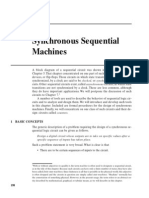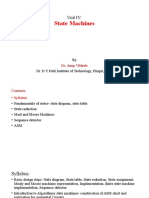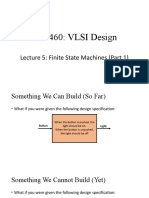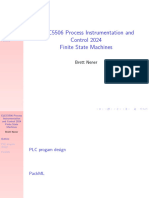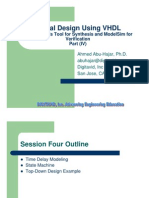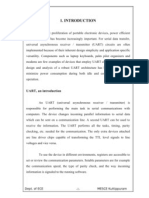Finite State Machines
Finite State Machines
Uploaded by
Maddalisai KrishnaCopyright:
Available Formats
Finite State Machines
Finite State Machines
Uploaded by
Maddalisai KrishnaOriginal Description:
Original Title
Copyright
Available Formats
Share this document
Did you find this document useful?
Is this content inappropriate?
Copyright:
Available Formats
Finite State Machines
Finite State Machines
Uploaded by
Maddalisai KrishnaCopyright:
Available Formats
Hardware Design with VHDL
Finite State Machines
ECE 443
Finite State Machines FSMs are sequential machines with "random" next-state logic Used to implement functions that are realized by carrying out a sequence of steps -- commonly used as a controller in a large system The state transitions within an FSM are more complicated than for regular sequential logic such as a shift register An FSM is specied using ve entities: symbolic states, input signals, output signals, next-state function and output function Mealy vs Moore output Mealy Mealy output outputs logic state_reg Moore Moore output outputs logic
state_next inputs clk ECE UNM 1 next state logic
q state reg.
(11/8/10)
Hardware Design with VHDL Finite State Machines State diagram
Finite State Machines
ECE 443
state_name moore< = val expr mealy <= val to other state
expr mealy <= val to other state
A node represents a unique state An arc represents a transition from one state to another Is labeled with the condition that causes the transition Moore outputs are shown inside the bubble Mealy outputs are shown on the arcs Only asserted outputs are listed
Consider a memory controller that sits between a processor and a memory unit Commands include mem, rw and burst mem is asserted when a memory access is requested rw when 1 indicates a read, when 0 indicates a write burst is a special read operation in which 4 consecutive reads occur Two control signals oe (output enable) and we (write enable) One Mealy output we_me ECE UNM 2 (11/8/10)
Hardware Design with VHDL
Finite State Machines
ECE 443
Finite State Machines The controller is initially in the idle state, waiting for mem to be asserted
Once mem is asserted, the FSM inspects the rw signal and moves to either the read1 or write state on rising edge of clk The logic expressions are given on the arcs They are checked on the rising edge of the clock For example, if mem is asserted and rw is 1, a transition is made to read1 and the output signal oe is asserted
ECE UNM
(11/8/10)
Hardware Design with VHDL
Finite State Machines
ECE 443
Finite State Machines Algorithmic State Machine (ASM) chart Flowchart-like diagram with transitions controlled by the rising edge of clk More descriptive and better for complex description than state diagrams state_name state box
moore <= val decision box F boolean cond. mealy <= val conditional output box
Each state box has only one exit and is usually followed by a decision box Conditional output boxes can only follow decision boxes and list the Mealy outputs that are asserted when we are in this state and the Boolean condition(s) is true EVERYTHING that follows a state box (to the next state) is next-state combo. logic! ECE UNM 4 (11/8/10)
Hardware Design with VHDL
Finite State Machines
ECE 443
Finite State Machines Conversion between state diagrams and ASMs
Conversion process is trivial for the left example For right example, a decision box is added to accommodate the conditional transition to state s1 when a is true. A conditional output box is added to handle the Mealy output that depends on both state_reg=s0 and a=1
ECE UNM
(11/8/10)
Hardware Design with VHDL Finite State Machines More examples
Finite State Machines
ECE 443
The same general structure is apparent for either state diagrams or ASMs The biggest difference is in how the decisions and conditional outputs are expressed When we code this in VHDL, you must view the decision and conditional output logic following a state (up to the next state(s)) as combinational next-state logic ECE UNM 6 (11/8/10)
Hardware Design with VHDL Finite State Machines
Finite State Machines
ECE 443
Memory controller conversion
ECE UNM
(11/8/10)
Hardware Design with VHDL
Finite State Machines
ECE 443
Finite State Machines Basic rules: For a given input combination, there is one unique exit path from the current ASM block The exit path of an ASM block must always lead to a state box. The state box can be the state box of the current ASM block or a state box of another ASM block. Incorrect ASM charts:
There are two exit paths (on the left) if a and b are both 1 and NO exit path (on the right) when a is 0 ECE UNM 8 (11/8/10)
Hardware Design with VHDL
Finite State Machines
ECE 443
Finite State Machines How do we interpret the ASM chart At the rising edge of clk, the FSM enters a new state (a new ASM block) During the clock period, the FSM performs several operations It activates Moore output signals asserted in this new state It evaluates various Boolean expressions of the decision boxes and activates the Mealy output signals accordingly At the next rising edge of clk (the end of the current clock period), the results of Boolean expression are examined simultaneously An exit path is determined and the FSM stays or enters a new ASM block Timing analysis of an FSM (similar to regular sequential circuit) Mealy output logic state_next q d state_reg next state state inputs Moore reg. logic output logic clk ECE UNM 9
Mealy outputs
Moore outputs
(11/8/10)
Hardware Design with VHDL
Finite State Machines
ECE 443
Timing Analysis of FSMs Consider a circuit with both a Moore and Mealy output
The timing parameters are Tcq, Tsetup, Thold, Tnext(max) Toutput(mo) (Moore logic) and Toutput(me) (Mealy logic) Similar to the analysis of a regular sequential circuit, the minimum clock period (max clk freq) of a FSM is given by Tc = Tcq + Tnext(max) + Tsetup ECE UNM 10 (11/8/10)
Hardware Design with VHDL Timing Analysis of FSMs Sample timing diagram
Finite State Machines
ECE 443
ECE UNM
11
(11/8/10)
Hardware Design with VHDL
Finite State Machines
ECE 443
Timing Analysis of FSMs Since the FSM is frequently used in a controller application, the delay of the output signals are important For Moore Tco(mo) = Tcq + Toutput(mo) For Mealy (when change is due to a change in state) Tco(me) = Tcq + Toutput(me) For Mealy (when change is due to a change in input signal(s)) Tco(me) = Toutput(me) Although the difference between a Moore and Mealy output seem subtle, as you can see from the timing diagram, there behaviors can be very different And, in general, it takes fewer states to realize a given function using a Mealy machine (note that both are equivalent in power) But greater care must be exercised
ECE UNM
12
(11/8/10)
Hardware Design with VHDL
Finite State Machines
ECE 443
Mealy vs Moore Consider an edge detection circuit The circuit is designed to detect the rising edge of a slow strobe input, i.e., it generates a "short" (1-clock period or less) output pulse
The input signal may be asserted for a long time (think of a pushbutton) -- the FSM has one state for long duration 0s and one state for long duration 1s The output, on the other hand, responds only to the rising edge and generates a pulse of much shorter duration ECE UNM 13 (11/8/10)
Hardware Design with VHDL
Finite State Machines
ECE 443
Mealy vs Moore The left-most design above is a Moore implementation, which additionally includes an edge state
Middle design is a Mealy machine The output p2 goes high in the zero state when strobe becomes 1 (after a small propagation delay), and stays high until the transition to state one on the next rising edge ECE UNM 14 (11/8/10)
Hardware Design with VHDL
Finite State Machines
ECE 443
Mealy vs Moore The right-most design includes both types of outputs and adds a third state delay The state diagram asserts p3 in the zero state (as in second version) when strobe goes high and transitions to delay state But since both transitions out of the delay state keep p2 asserted, this has the effect of adding a clock cycle to p2s high state (as in the rst version) Since the assertion is on all outgoing arcs, it is high independent of the input conditions (and can be added inside the bubble as a Moore output) All three designs generate a shot pulse but with subtle differences -- understanding these differences is key to deriving a correct and efcient FSM There are three main differences between Mealy and Moore: Mealy machine uses fewer states -- the input dependency allows several output values to be specied in the same state Mealy machine responds faster -- one clock cycle earlier in systems that use output Mealy machine may be transparent to glitches, i.e., passing them to the output ECE UNM 15 (11/8/10)
Hardware Design with VHDL Mealy vs Moore So which one is better?
Finite State Machines
ECE 443
For control system applications, we can divide control signals into two categories, edge sensitive and level sensitive An edge sensitive signal (e.g., the enable signal on a counter) is sampled only on the rising edge of clock Therefore, glitches do NOT matter -- only the setup and hold times must be obeyed Both Mealy and Moore machines can generate output signals that meet this requirement However, Mealy machines are preferred because it responds one clk cycle faster and uses fewer states For a level sensitive control signal, the signal must be asserted for a certain interval of time (e.g., the write enable signal of an SRAM chip) and Moore is preferred While asserted, it MUST remain stable and free of glitches ECE UNM 16 (11/8/10)
Hardware Design with VHDL
Finite State Machines
ECE 443
VHDL Description of FSM Coding FSMs is similar to regular sequential logic, e.g., separate the memory elements out and derive the next-state/output logic There are two differences Symbolic states are used in an FSM description -- we use the enumeration VHDL data type for the state registers The next-state logic needs to be constructed according to a state diagram or ASM, as opposed to using regular combinational logic such as a incrementer or shifter There are several coding styles Multi-Segment: Create a VHDL code segment for each block in the block diagram Memory controller example
ECE UNM
17
(11/8/10)
Hardware Design with VHDL VHDL Description of FSM
Finite State Machines
ECE 443
ECE UNM
18
(11/8/10)
Hardware Design with VHDL
Finite State Machines
ECE 443
Multi-Segment VHDL Description of FSM library ieee; use ieee.std_logic_1164.all; entity mem_ctrl is port( clk, reset: in std_logic; mem, rw, burst: in std_logic; oe, we, we_me: out std_logic ); end mem_ctrl ; architecture mult_seg_arch of mem_ctrl is type mc_state_type is (idle, read1, read2, read3, read4, write); signal state_reg, state_next: mc_state_type; begin
ECE UNM
19
(11/8/10)
Hardware Design with VHDL
Finite State Machines
ECE 443
Multi-Segment VHDL Description of FSM -- state register process(clk, reset) begin if (reset = 1) then state_reg <= idle; elsif (clkevent and clk = 1) then state_reg <= state_next; end if; end process; -- next-state logic process(state_reg, mem, rw, burst) begin case state_reg is -- When multiple transitions exist out of a state, -- use an if stmt when idle => if (mem = 1) then ECE UNM 20 (11/8/10)
Hardware Design with VHDL
Finite State Machines then <= read1; <= write;
ECE 443
Multi-Segment VHDL Description of FSM if (rw = 1) state_next else state_next end if; else state_next <= end if;
idle;
when write => state_next <= idle; when read1 => if (burst = 1) then state_next <= read2; else state_next <= idle; end if; ECE UNM 21 (11/8/10)
Hardware Design with VHDL
Finite State Machines
ECE 443
Multi-Segment VHDL Description of FSM when read2 => state_next <= read3; when read3 => state_next <= read4; when read4 => state_next <= idle; end case; end process; -- Moore output logic process(state_reg) begin we <= 0; -- default value oe <= 0; -- default value
ECE UNM
22
(11/8/10)
Hardware Design with VHDL
Finite State Machines
ECE 443
Multi-Segment VHDL Description of FSM case state_reg is when idle => when write => we <= 1; when read1 => oe <= 1; when read2 => oe <= 1; when read3 => oe <= 1; when read4 => oe <= 1; end case; end process;
ECE UNM
23
(11/8/10)
Hardware Design with VHDL
Finite State Machines
ECE 443
Multi-Segment VHDL Description of FSM -- Mealy output logic process(state_reg, mem, rw) begin we_me <= 0; -- default value case state_reg is when idle => if (mem = 1) and (rw = 0) then we_me <= 1; end if; when write => when read1 => when read2 => when read3 => when read4 => end case; end process; end mult_seg_arch;
ECE UNM
24
(11/8/10)
Hardware Design with VHDL
Finite State Machines
ECE 443
Two-Segment VHDL Description of FSM Combine next-state/output logic into one process
architecture two_seg_arch of mem_ctrl is type mc_state_type is (idle, read1, read2, read3, read4, write); signal state_reg, state_next: mc_state_type; begin
ECE UNM
25
(11/8/10)
Hardware Design with VHDL
Finite State Machines
ECE 443
Two-Segment VHDL Description of FSM -- state register process(clk, reset) begin if (reset=1) then state_reg <= idle; elsif (clkevent and clk = 1) then state_reg <= state_next; end if; end process; -- next-state logic and output logic process(state_reg, mem, rw, burst) begin oe <= 0; -- default values we <= 0; we_me <= 0;
ECE UNM
26
(11/8/10)
Hardware Design with VHDL
Finite State Machines
ECE 443
Two-Segment VHDL Description of FSM case state_reg is when idle => if (mem = 1) then if (rw = 1) then state_next <= read1; else state_next <= write; we_me <= 1; end if; else state_next <= idle; end if; when write => state_next <= idle; we <= 1;
ECE UNM
27
(11/8/10)
Hardware Design with VHDL
Finite State Machines
ECE 443
Two-Segment VHDL Description of FSM when read1 => if (burst=1) then state_next <= read2; else state_next <= idle; end if; oe <= 1; when read2 => state_next <= read3; oe <= 1; when read3 => state_next <= read4; oe <= 1;
ECE UNM
28
(11/8/10)
Hardware Design with VHDL
Finite State Machines
ECE 443
Two-Segment VHDL Description of FSM when read4 => state_next <= idle; oe <= 1; end case; end process; end two_seg_arch; State Assignment State assignment is the process of assigning a binary representations to the set of symbolic states Although any arbitrary assignment works for a synchronous FSM, some assignments reduce the complexity of next-state/output logic and allows faster operation Typical assignment strategies: Binary -- requires ceiling(log2n)-bit register Gray -- also minimal size but may reduce complexity of next-state logic One-hot or Almost one-hot (includes "0 ...0") -- requires n-bit register ECE UNM 29 (11/8/10)
Hardware Design with VHDL
Finite State Machines
ECE 443
State Assignment Example for memory controller:
State assignment can be controlled in VHDL either implicitly or explicitly For implicit state assignment, use user attributes which acts as a "directive" to guide the CAD synthesis software The 1076.6 RTL synthesis standard denes an attribute named enum_encoding for specifying the values for an enumeration data type This attribute can be used for specifying state assignment, as shown below
ECE UNM
30
(11/8/10)
Hardware Design with VHDL
Finite State Machines
ECE 443
State Assignment type mc_state_type is (idle, write, read1, read2, read3, read4); attribute enum_encoding: string; attribute enum_encoding of mc_state_type: type is "0000 0100 1000 1001 1010 1011"; This user attribute is very common is should be accepted by most synthesis software Explicit state assignment is accomplished by replacing the symbolic values with actual binary representations architecture state_assign_arch of mem_ctrl is constant idle: std_logic_vector(3 downto 0):="0000"; constant write: std_logic_vector(3 downto 0):="0100"; constant read1: std_logic_vector(3 downto 0):="1000"; constant read2: std_logic_vector(3 downto 0):="1001"; constant read3: std_logic_vector(3 downto 0):="1010"; constant read4: std_logic_vector(3 downto 0):="1011";
ECE UNM
31
(11/8/10)
Hardware Design with VHDL
Finite State Machines
ECE 443
State Assignment signal state_reg, state_next: std_logic_vector(3 downto 0); begin -- state register process(clk, reset) begin if (reset = 1) then state_reg <= idle; elsif (clkevent and clk = 1) then state_reg <= state_next; end if; end process; -- next-state logic process(state_reg, mem, rw, burst) begin
ECE UNM
32
(11/8/10)
Hardware Design with VHDL
Finite State Machines
ECE 443
State Assignment case state_reg is when idle => if (mem = 1) then if (rw = 1) then state_next <= read1; else state_next <= write; end if; else state_next <= idle; end if; when write => state_next <= idle; when read1 => if (burst = 1) then
ECE UNM
33
(11/8/10)
Hardware Design with VHDL State Assignment
Finite State Machines
ECE 443
state_next <= read2; else state_next <= idle; end if; when read2 => state_next <= read3; when read3 => state_next <= read4; when read4 => state_next <= idle; -- Need this now to cover other std_logic_vector vals when others => state_next <= idle; end case; end process; ECE UNM 34 (11/8/10)
Hardware Design with VHDL
Finite State Machines
ECE 443
State Assignment -- Moore output logic process(state_reg) begin we <= 0; -- default value oe <= 0; -- default value case state_reg is when idle => when write => we <= 1; when read1 => oe <= 1; when read2 => oe <= 1; when read3 => oe <= 1; when read4 => oe <= 1; when others => ECE UNM 35 (11/8/10)
Hardware Design with VHDL State Assignment end case; end process;
Finite State Machines
ECE 443
-- Mealy output logic we_me <= 1 when ((state_reg = idle) and (mem = 1) and(rw = 0)) else 0; end state_assign_arch; Moore Output Buffering Output buffering involves adding a D FF to drive the output signal The purpose is to remove glitches (and minimize clock-to-output delay (Tco)) The disadvantage is that the output is delayed by one clock cycle However, for a Moore output, it is possible to obtain a buffered signal without this delay penalty. ECE UNM 36 (11/8/10)
Hardware Design with VHDL
Finite State Machines
ECE 443
Moore Output Buffering There are two possible solutions Buffering by clever state assignment A Moore output is shielded from glitches in the input signals, but not from glitches in the state transition and output logic Glitches in the state transition can result from multiple-bit transitions of the state register, e.g., from the "111" to "000" states Even though the state registers are controlled by the same clk, variations in the Tcq of the D FFs can produce glitches Recall that Tco is the sum of Tcq and Toutput One way to reduce the effect on Tco introduced by the output logic is to eliminate it completely by clever state assignment To accomplish this, add bits to the state encoding that specify the behavior of the output signals ECE UNM 37 (11/8/10)
Hardware Design with VHDL
Finite State Machines
ECE 443
Moore Output Buffering You will also need to specify state assignment explicitly Consider the memory controller -- we can specify the state of the outputs oe and we in bits q3 and q2 and the actual state in bits q1 and q0.
This encoding scheme was used in the previous code segment
So, we see that oe and we are given directly by state_reg(3) and state_reg(2) oe <= state_reg(3); -- modify the previous code seg by we <= state_reg(2); -- replacing output logic with these Therefore, the output logic is eliminated and Tco is reduced to Tcq Unfortunately, this scheme is difcult to modify and maintain ECE UNM 38 (11/8/10)
Hardware Design with VHDL
Finite State Machines
ECE 443
Look-Ahead Output Circuit A more systematic approach to eliminate the one-clock output buffer delay is to use the state_next signal instead of the state_reg signal
This works because the next output signal is a function of the next state logic Only drawback is that the critical path is likely extended through the next output logic ECE UNM 39 (11/8/10)
Hardware Design with VHDL
Finite State Machines
ECE 443
Look-Ahead Output Circuit architecture look_ahead_buffer_arch of mem_ctrl is type mc_state_type is (idle, read1, read2, read3, read4, write); signal state_reg, state_next: mc_state_type; signal oe_next, we_next, oe_buf_reg, we_buf_reg: std_logic; begin -- state register process(clk, reset) begin if (reset = 1) then state_reg <= idle; elsif (clkevent and clk = 1) then state_reg <= state_next; end if; end process;
ECE UNM
40
(11/8/10)
Hardware Design with VHDL
Finite State Machines
ECE 443
Look-Ahead Output Circuit -- output buffer process(clk, reset) begin if (reset = 1) oe_buf_reg <= we_buf_reg <= elsif (clkevent oe_buf_reg <= we_buf_reg <= end if; end process;
then 0; 0; and clk = 1) then oe_next; we_next;
-- next-state logic process(state_reg, mem, rw, burst) begin case state_reg is
ECE UNM
41
(11/8/10)
Hardware Design with VHDL
Finite State Machines
ECE 443
Look-Ahead Output Circuit when idle => if (mem = 1) then if (rw = 1) then state_next <= read1; else state_next <= write; end if; else state_next <= idle; end if; when write => state_next <= idle; when read1 => if (burst = 1) then state_next <= read2;
ECE UNM
42
(11/8/10)
Hardware Design with VHDL
Finite State Machines
ECE 443
Look-Ahead Output Circuit else state_next <= idle; end if; when read2 => state_next <= read3; when read3 => state_next <= read4; when read4 => state_next <= idle; end case; end process;
ECE UNM
43
(11/8/10)
Hardware Design with VHDL
Finite State Machines
ECE 443
Look-Ahead Output Circuit -- look-ahead output logic process(state_next) begin we_next <= 0; -- default value oe_next <= 0; -- default value case state_next is when idle => when write => we_next <= 1; when read1 => oe_next <= 1; when read2 => oe_next <= 1; when read3 => oe_next <= 1; when read4 => oe_next <= 1; end case; end process; ECE UNM 44 (11/8/10)
Hardware Design with VHDL
Finite State Machines
ECE 443
Look-Ahead Output Circuit -- output we <= we_buf_reg; oe <= oe_buf_reg; end look_ahead_buffer_arch; FSM Design Examples Edge detecting circuit (Moore)
The VHDL code for version 1 of edge detection circuit we saw earlier ECE UNM 45 (11/8/10)
Hardware Design with VHDL
Finite State Machines
ECE 443
Edge Detection Circuit library ieee; use ieee.std_logic_1164.all; entity edge_detector1 is port( clk, reset: in std_logic; strobe: in std_logic; p1: out std_logic ); end edge_detector1; architecture moore_arch of edge_detector1 is type state_type is (zero, edge, one); signal state_reg, state_next: state_type; begin
ECE UNM
46
(11/8/10)
Hardware Design with VHDL
Finite State Machines
ECE 443
Edge Detection Circuit -- state register process(clk, reset) begin if (reset = 1) then state_reg <= zero; elsif (clkevent and clk = 1) then state_reg <= state_next; end if; end process; -- next-state logic process(state_reg, strobe) begin case state_reg is when zero=> if (strobe = 1) then state_next <= edge; else ECE UNM 47 (11/8/10)
Hardware Design with VHDL Edge Detection Circuit
Finite State Machines
ECE 443
state_next <= zero; end if; when edge => if (strobe = 1) then state_next <= one; else state_next <= zero; end if; when one => if (strobe = 1) then state_next <= one; else state_next <= zero; end if; end case; end process; ECE UNM 48 (11/8/10)
Hardware Design with VHDL
Finite State Machines
ECE 443
-- Moore output logic p1 <= 1 when state_reg = edge else 0; end moore_arch; If we need to the output to be glitch-free, we can use the clever state assignment shown below or the look-ahead output scheme
ECE UNM
49
(11/8/10)
Hardware Design with VHDL
Finite State Machines
ECE 443
Edge Detection Circuit Edge detecting circuit (Mealy)
library ieee; use ieee.std_logic_1164.all; entity edge_detector2 is port( clk, reset: in std_logic; strobe: in std_logic; p2: out std_logic ECE UNM 50 (11/8/10)
Hardware Design with VHDL
Finite State Machines
ECE 443
); end edge_detector2; architecture mealy_arch of edge_detector2 is type state_type is (zero, one); signal state_reg, state_next: state_type; begin -- state register process(clk, reset) begin if (reset = 1) then state_reg <= zero; elsif (clkevent and clk = 1) then state_reg <= state_next; end if; end process;
ECE UNM
51
(11/8/10)
Hardware Design with VHDL
Finite State Machines
ECE 443
Edge Detection Circuit -- next-state logic process(state_reg, strobe) begin case state_reg is when zero=> if (strobe = 1) then state_next <= one; else state_next <= zero; end if; when one => if (strobe = 1) then state_next <= one; else state_next <= zero; end if; end case; end process; ECE UNM 52 (11/8/10)
Hardware Design with VHDL
Finite State Machines
ECE 443
Edge Detection Circuit -- Mealy output logic p2 <= 1 when (state_reg = zero) and (strobe = 1) else 0; end mealy_arch; An alternative to deriving the edge detection circuit is to treat it as a regular sequential circuit and design it in an ad hoc manner
Output p2 is asserted when the previous value in FF is 0 and the new value is (strobe) is 1 -- this represents an edge Note that the output is a Mealy output (subject to glitches) -- what does the timing diagram look like?
ECE UNM
53
(11/8/10)
Hardware Design with VHDL
Finite State Machines
ECE 443
Edge Detection Circuit architecture direct_arch of edge_detector2 is signal delay_reg: std_logic; begin -- delay register process(clk, reset) begin if (reset = 1) then delay_reg <= 0; elsif (clkevent and clk = 1) then delay_reg <= strobe; end if; end process; -- decoding logic p2 <= (not delay_reg) and strobe; end direct_arch; Text covers an Arbiter circuit ECE UNM 54 (11/8/10)
Hardware Design with VHDL
Finite State Machines
ECE 443
DRAM Strobe Signal Generation The address signals of a DRAM are split into two parts, row and column They are sent to the DRAM from the controller in a time-multiplexed manner Two signals, ras_n (active low row access strobe) and cas_n are de-asserted to instruct the DRAM to latch the addresses internally
There are several timing parameters associated with a (simplied) DRAM Tras and Tcas: ras/cas access time -- time required to obtain output data after ras_n/ cas_n are de-asserted
ECE UNM
55
(11/8/10)
Hardware Design with VHDL
Finite State Machines
ECE 443
DRAM Strobe Signal Generation Tpr: precharge time -- the time to recharge the DRAM cell to restore the destroyed original value after a read Trc: read cycle -- minimum elapsed time between two read operations DRAMs are asynchronous (do not have a clk input) Instead the strobe signals have to de-asserted in a proper sequence and be held long enough to allow for decoding, multiplexing and recharging A memory controller is the interface between a DRAM device and a synchronous system Its primary function is to generate the proper strobe signals A full blown read controller should contain registers to store address and data, plus extra control signals to coordinate the address and data bus operations Assume our DRAM card has the following parameters 120 ns DRAM (Trc = 120 ns): Tras = 85 ns, Tcas = 20 ns, Tpr = 35 ns ECE UNM 56 (11/8/10)
Hardware Design with VHDL
Finite State Machines
ECE 443
DRAM Strobe Signal Generation Our task is to design an FSM that generates the strobe signals, ras_n and cas_n after the input command signal mem is asserted From the timing diagram ras_n is de-asserted rst for 65 ns (output pattern of FSM is "01" in this interval cas_n is then de-asserted for at least 20 ns (output pattern is "00") The ras_n and cas_n signals are re-asserted for at least 35 ns ("11")
Three states + idle for no-op
First design uses state to generate the pattern and divides a read cycle into three states, r, c and p ECE UNM 57 (11/8/10)
Hardware Design with VHDL
Finite State Machines
ECE 443
DRAM Strobe Signal Generation We also use a Moore machine because it has better control over the width of the intervals (level-sensitive) and the outputs can be easily made glitch-free For this design, clock cycle needs to be at least 65 ns to satisfy the timing constraints Therefore, this is a slow design because read cycle time is 195 ns (3*65 ns) library ieee; use ieee.std_logic_1164.all; entity dram_strobe is port( clk, reset: in std_logic; mem: in std_logic; cas_n, ras_n: out std_logic ); end dram_strobe;
ECE UNM
58
(11/8/10)
Hardware Design with VHDL
Finite State Machines
ECE 443
DRAM Strobe Signal Generation architecture fsm_slow_clk_arch of dram_strobe is type fsm_state_type is (idle, r, c, p); signal state_reg, state_next: fsm_state_type; begin -- state register process(clk, reset) begin if (reset = 1) then state_reg <= idle; elsif (clkevent and clk = 1) then state_reg <= state_next; end if; end process;
ECE UNM
59
(11/8/10)
Hardware Design with VHDL
Finite State Machines
ECE 443
DRAM Strobe Signal Generation -- next-state logic process(state_reg, mem) begin case state_reg is when idle => if (mem = 1) then state_next <= r; else state_next <= idle; end if; when r => state_next <=c; when c => state_next <=p;
ECE UNM
60
(11/8/10)
Hardware Design with VHDL
Finite State Machines
ECE 443
DRAM Strobe Signal Generation when p => state_next <=idle; end case; end process; -- output logic process(state_reg) begin ras_n <= 1; cas_n <= 1; case state_reg is when idle => when r => ras_n <= 0; when c => ras_n <= 0; cas_n <= 0;
ECE UNM
61
(11/8/10)
Hardware Design with VHDL
Finite State Machines
ECE 443
DRAM Strobe Signal Generation when p => end case; end process; end fsm_slow_clk_arch; Since the strobe signals are level-sensitive, we have to ensure that these signals are glitch-free by, e.g., adding a look-ahead output buffer A faster design must use a clock period that is smaller to accommodate the differences in the three intervals For example, if we use a 20 ns clock period then the three output patterns need ceiling(65/20) or 4 states for r ceiling(20/20) or 1 state for c ceiling(35/20) or 2 states for p This reduces the read cycle to 140 ns (7*20 ns) -- down from 195 ns
ECE UNM
62
(11/8/10)
Hardware Design with VHDL
Finite State Machines
ECE 443
DRAM Strobe Signal Generation One way to implement this is to split the r and p states -- make multiple states where one existed originally
The minimum read cycle time for the memory can be achieved using a clock period of 5 ns (largest factor evenly divisible into all three parameters) This would yield 13 states + 4 states + 7 states for r, c and p, respectively A better approach is to use counters in each state as we will see later ECE UNM 63 (11/8/10)
Hardware Design with VHDL
Finite State Machines
ECE 443
DRAM Strobe Signal Generation Text covers a Manchester encoding circuit In reality, all sequential circuits, including regular sequential circuits, can be modeled by FSMs Consider a free-running mod-16 binary counter consider earlier Expressed as an FSM, it is an extremely regular structure with 16 states
We can modify this easily to add features as we did earlier Original
To add synchronous clear
ECE UNM
64
(11/8/10)
Hardware Design with VHDL
Finite State Machines
ECE 443
DRAM Strobe Signal Generation To add the load operation, need to add 1 control signal and a 4-bit data signal To add load Note: 16 additional transitions are needed here
To add enable Note: Logic expression establish priority with syn_clr highest, followed by load and then enable This becomes extremely tedious, especially for larger counters Therefore, for regular sequential circuits, we do NOT employ this strategy ECE UNM 65 (11/8/10)
You might also like
- Lecture 11Document21 pagesLecture 11fotescuiondaniel7No ratings yet
- DSD Experiment 7Document8 pagesDSD Experiment 7Vidya SagvekarNo ratings yet
- Week #6 - Verilog Behavioural Modeling (Part 4) FSMDocument18 pagesWeek #6 - Verilog Behavioural Modeling (Part 4) FSMKhayrinNajmiNo ratings yet
- Finite State Machine (FSM) : ExampleDocument22 pagesFinite State Machine (FSM) : ExampleDanish WilsonNo ratings yet
- Tap FSMDocument39 pagesTap FSMMadhukumar KsNo ratings yet
- L8-Complex FSM 3pDocument14 pagesL8-Complex FSM 3pAlbertoCasNo ratings yet
- Lect8 RTL DesignDocument33 pagesLect8 RTL DesignmlpNo ratings yet
- Finite State MachinesDocument17 pagesFinite State Machineslashali1212No ratings yet
- Advance Oral OnlioneDocument6 pagesAdvance Oral Onlionepriom ahmedNo ratings yet
- DSD Lab Manual 5 21 CPDocument6 pagesDSD Lab Manual 5 21 CPUsman AbdullahNo ratings yet
- Ise VHDL State Machine Process NEXYS3 SOEDocument14 pagesIse VHDL State Machine Process NEXYS3 SOEmdzakir_hussainNo ratings yet
- Finite-State Machine (FSM) : TaskDocument7 pagesFinite-State Machine (FSM) : TaskelexboyNo ratings yet
- Chapter01 - Sequential Logic-Advanced PDFDocument66 pagesChapter01 - Sequential Logic-Advanced PDFTrần Thảo NguyênNo ratings yet
- ECE545 Lecture 13 Controllers Part ADocument46 pagesECE545 Lecture 13 Controllers Part Ascribd.livestock059No ratings yet
- FSM ASM DiagramasDocument56 pagesFSM ASM Diagramasvaz5z100% (1)
- Finite State Machine Design and VHDL Coding Techniques: Iuliana CHIUCHISAN, Alin Dan POTORAC, Adrian GRAURDocument6 pagesFinite State Machine Design and VHDL Coding Techniques: Iuliana CHIUCHISAN, Alin Dan POTORAC, Adrian GRAURjavedfmNo ratings yet
- Digital Logic DesignDocument68 pagesDigital Logic Designsunny louisNo ratings yet
- Tarea 3 Arnold Phillips ICRDocument6 pagesTarea 3 Arnold Phillips ICRArnold A. Phillips D.No ratings yet
- RiscDocument10 pagesRiscMd RasheedNo ratings yet
- EXP3Document10 pagesEXP3pilawak670No ratings yet
- Asm and AsmdDocument39 pagesAsm and AsmdRamiro Russo NegrónNo ratings yet
- DLD Term ProjectDocument10 pagesDLD Term ProjectH052 Rajesh Komaravalli ECENo ratings yet
- 10 ISD 2022-23 Part3 TP2 FSM AnalysisDocument29 pages10 ISD 2022-23 Part3 TP2 FSM AnalysisPedro NevesNo ratings yet
- FSM DesignDocument61 pagesFSM DesignParesh SawantNo ratings yet
- Finite State Machines Using HDL: Here We Will LearnDocument12 pagesFinite State Machines Using HDL: Here We Will LearndebanjanbulanNo ratings yet
- State MachinesDocument6 pagesState MachinesHelios FlaresNo ratings yet
- Application of Finite AutomataDocument9 pagesApplication of Finite AutomataPriyanka GoyalNo ratings yet
- Sequence Detector PaperDocument8 pagesSequence Detector PaperVicky RNo ratings yet
- Assinmint #2 Roll No 1314 DLDDocument9 pagesAssinmint #2 Roll No 1314 DLDkalsoomu541No ratings yet
- Lecture 8 FSMDocument41 pagesLecture 8 FSMrahulNo ratings yet
- Piranti Terprogram - Pertemuan 6 FSM 2020 BDocument14 pagesPiranti Terprogram - Pertemuan 6 FSM 2020 BAhmad KafabiNo ratings yet
- Module 5Document17 pagesModule 5exlgamer123No ratings yet
- Finite State Machines: State Diagrams vs. Algorithmic State Machine (ASM) ChartsDocument46 pagesFinite State Machines: State Diagrams vs. Algorithmic State Machine (ASM) ChartsManuel Garay GutierrezNo ratings yet
- 09-Logic Design With ASM Chart-11-07Document58 pages09-Logic Design With ASM Chart-11-07Sandeep ChaudharyNo ratings yet
- We Know That Synchronous Sequential Circuits ChangeDocument7 pagesWe Know That Synchronous Sequential Circuits ChangeMario MonaNo ratings yet
- Markov 123Document108 pagesMarkov 123rafeshNo ratings yet
- Basic DFANFA RegularDocument33 pagesBasic DFANFA RegularSouvik GonNo ratings yet
- ASM Chart: Multiplier Control COE608: Computer Organization and ArchitectureDocument50 pagesASM Chart: Multiplier Control COE608: Computer Organization and ArchitectureKasaragadda MahanthiNo ratings yet
- Unit - 1 DSDDocument56 pagesUnit - 1 DSDultimatekp144No ratings yet
- State Machine DesignDocument20 pagesState Machine DesignAnonymous pHi4dXNo ratings yet
- Onur Digitaldesign Comparch 2021 Lecture8 Timing and Verification AfterlectureDocument129 pagesOnur Digitaldesign Comparch 2021 Lecture8 Timing and Verification AfterlecturePhươngg NguyễnnNo ratings yet
- DC - Unit V - ASVDocument32 pagesDC - Unit V - ASVAnup S. Vibhute DITNo ratings yet
- CSE460: VLSI Design: Lecture 5: Finite State Machines (Part 1)Document13 pagesCSE460: VLSI Design: Lecture 5: Finite State Machines (Part 1)Shovon BhowmickNo ratings yet
- Experiment 3 Algorithmic State Machines (Asm) PURPOSE: Getting Acquainted With ASM ChartsDocument6 pagesExperiment 3 Algorithmic State Machines (Asm) PURPOSE: Getting Acquainted With ASM ChartsAr-Jay MadejaNo ratings yet
- ) Explain About Setup Time and Hold Time, What Will Happen If There Is Setup Time and Hold Tine Violation, How To Overcome This?Document7 pages) Explain About Setup Time and Hold Time, What Will Happen If There Is Setup Time and Hold Tine Violation, How To Overcome This?Uday KumarNo ratings yet
- PLC FSM SlidesDocument27 pagesPLC FSM Slidesisabelleabrahams20No ratings yet
- Lect5 FSMDocument23 pagesLect5 FSMSangeetha BajanthriNo ratings yet
- Fpga Implementation of Memory Controller FSM Using Simulink2Document57 pagesFpga Implementation of Memory Controller FSM Using Simulink2AKNo ratings yet
- ECE448 Lecture6 ASM ChartsDocument36 pagesECE448 Lecture6 ASM Chartskavimozhi123wwwNo ratings yet
- How To Avoid Lock Out ConditionDocument3 pagesHow To Avoid Lock Out ConditionSiva Guru100% (1)
- Lec19 FSMDocument14 pagesLec19 FSMGAURAV KUMARNo ratings yet
- HDL and Fpga Ch07 HVT 2024 FSMDocument20 pagesHDL and Fpga Ch07 HVT 2024 FSMTuấn Vũ Lê NguyễnNo ratings yet
- Digital Design Using VHDL: Using Xilinx'S Tool For Synthesis and Modelsim For Verification Part (Iv)Document17 pagesDigital Design Using VHDL: Using Xilinx'S Tool For Synthesis and Modelsim For Verification Part (Iv)Rakesh Kumar DNo ratings yet
- Digital Design Interview Questions & AnswersDocument8 pagesDigital Design Interview Questions & Answersmohit009dudeNo ratings yet
- ESE63201 L4 Digital Logic ReviewDocument12 pagesESE63201 L4 Digital Logic Reviewmohed_kamalNo ratings yet
- Capstone ResearchProject Moore Mealy MachineDocument9 pagesCapstone ResearchProject Moore Mealy MachineAnish ChatterjeeNo ratings yet
- Low Power UART Design For Serial Data CommunicationDocument21 pagesLow Power UART Design For Serial Data CommunicationSuman Gm100% (1)
- Investigation of the Usefulness of the PowerWorld Simulator Program: Developed by "Glover, Overbye & Sarma" in the Solution of Power System ProblemsFrom EverandInvestigation of the Usefulness of the PowerWorld Simulator Program: Developed by "Glover, Overbye & Sarma" in the Solution of Power System ProblemsNo ratings yet






































